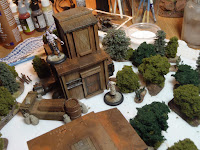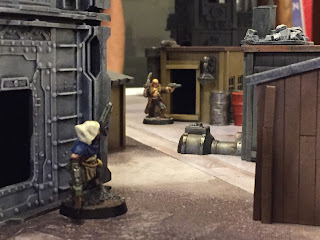Things Gone and Those to Come
2016 was a year of considerable change for my family and I.
Above all else, it was the year in which we finally ended our time in the
Midwest and made our return to Colorado. This move had always been the 5-year
plan for us, but it took us by surprise when we realized that we had actually
achieved what we set out to do. Perhaps more unbelievable is the realization
that the end of this month makes it 1 year since the move. The process has been
somewhat jarring and it has been a whirlwind of a year. And so as our first
year in Denver comes to a close, our focus turns from ‘getting here’ to really
setting up a life here.
That’s to give you an idea of where my mind is but in
reality, 2016 was a fairly productive year in terms of hobby. The year saw me
paint more models than I have in a number of years and while painting for me has always been a
slow process, I’ve grown as an artist and I am constantly looking for new ways
to improve. On the terrain end of my hobby, I’m continuing to create high
quality terrain and maintain my ‘no compromises’ approach. But that’s enough
ranting. Over the next few posts, I’m going to be catching up with the things I’ve
been working on and then back to normal….or as close to normal as it gets these
days.
Visions of Confluence
 As the larger structures and character of my Malifaux
terrain project develop, I am constantly looking for ways to make the tables
feel more real. Some time ago I had a chance to set up a full table and it gave
me a chance to stand back, be impressed with the work I’ve done so far and
evaluate what was missing.
As the larger structures and character of my Malifaux
terrain project develop, I am constantly looking for ways to make the tables
feel more real. Some time ago I had a chance to set up a full table and it gave
me a chance to stand back, be impressed with the work I’ve done so far and
evaluate what was missing.
While this is certainly a dense table, it was definitely
missing something. The first add was the cacti I’ve talked about in a previous
post. While they add a great deal of character to the table, they also change
gameplay, as they are typically to be considered dangerous terrain. What I
needed was something to make the world look a bit more alive, so I went back to
my reference photos and found the answer.
In the reference pic, you can see these tall grasses and
bushes and shrubs that liter the ground between structures. As many of the
buildings on the table are little more than hovels, they have simply been built
into the surrounding world, leaving only fragments of the once lush woods
behind.
 The ground cover started as several plastic-card base. In the end,
these bases ended up being something of a hybrid of the cacti and my woods,
built up with small stones and drywall compound. (My only warning with this
process is that you need to be careful about making oblong shapes as they can
bend slightly as the compound and eventually the glue, dries). As before, the
initial texture was a fine sand mix, followed by increasingly larger pebbles to
form a natural look. I then went back to some areas with a super fine dust to
give the appearance of baked and wind-whipped dirt.
The ground cover started as several plastic-card base. In the end,
these bases ended up being something of a hybrid of the cacti and my woods,
built up with small stones and drywall compound. (My only warning with this
process is that you need to be careful about making oblong shapes as they can
bend slightly as the compound and eventually the glue, dries). As before, the
initial texture was a fine sand mix, followed by increasingly larger pebbles to
form a natural look. I then went back to some areas with a super fine dust to
give the appearance of baked and wind-whipped dirt.
Once dry and primed black, it was time to paint. I have to
admit I’ve been struggling with the paint scheme for the dirt around
Confluence. With the rock outcroppings, I had a pretty decent orangey earth
look going, which became more red when I worked on the woods. This was carried
over to the cacti, but for the other ground cover, I wanted to head more
towards a rich brown mix. I don’t think I’ve got it just yet, but I’m in orbit.
Finally I began to add the life itself, first in patches of
static grass, then in some small broken logs and twigs to litter the ground.
Some patches of taller grass and a flower here and there added some color and
then I finally dropped the larger shrubs and small trees. If you haven’t
already tried them, I highly recommend Shadow’s Edge Miniatures for their
grasses and flowers. I’ve used several and these have been the best so far.

 For the larger bushes, I opted to use woodland scenic clump
foliage. However, rather than just using the standard bag of foliage, I purchased
a couple of ready-made trees. These are just plastic tree skeletons with clumps
glued on, but the skeletons gave more rigidity than I’d be able to get from
just the foliage and added some realism when you see an branch poking out here
and there.
For the larger bushes, I opted to use woodland scenic clump
foliage. However, rather than just using the standard bag of foliage, I purchased
a couple of ready-made trees. These are just plastic tree skeletons with clumps
glued on, but the skeletons gave more rigidity than I’d be able to get from
just the foliage and added some realism when you see an branch poking out here
and there.
I have yet to set up another table now that the scatter
terrain is built, but in some of my quick little pictures, I’m already much
more impressed with the immersion this table will create.
As always, I thank you for taking the time to have a look
and I love to see comments with your thoughts.
More to come.






Comments
Post a Comment